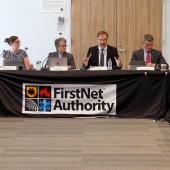Episode 55: FirstNet Helps Wyoming Responders Prepare for Fires, Floods, and Blizzards
Teton County is a rural county in northwest Wyoming. Situated in the Teton Range, the county experiences weather hazards including fires, floods, and wintery conditions, as well as earthquakes, landslides, and avalanches. Teton County first responders rely on FirstNet’s hardened network to stay connected in the most remote parts of the county and during tourist season when cell networks grow congested.











